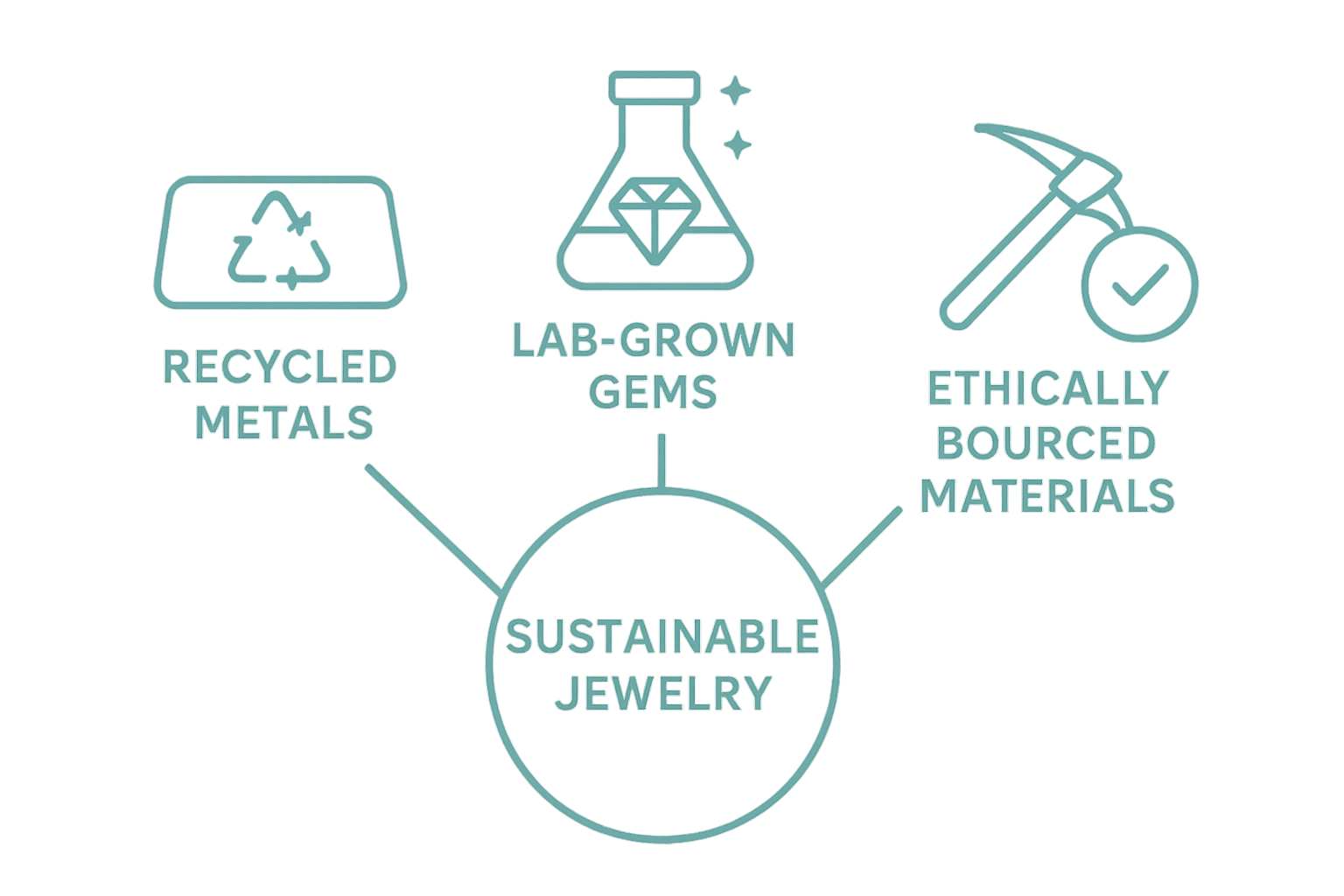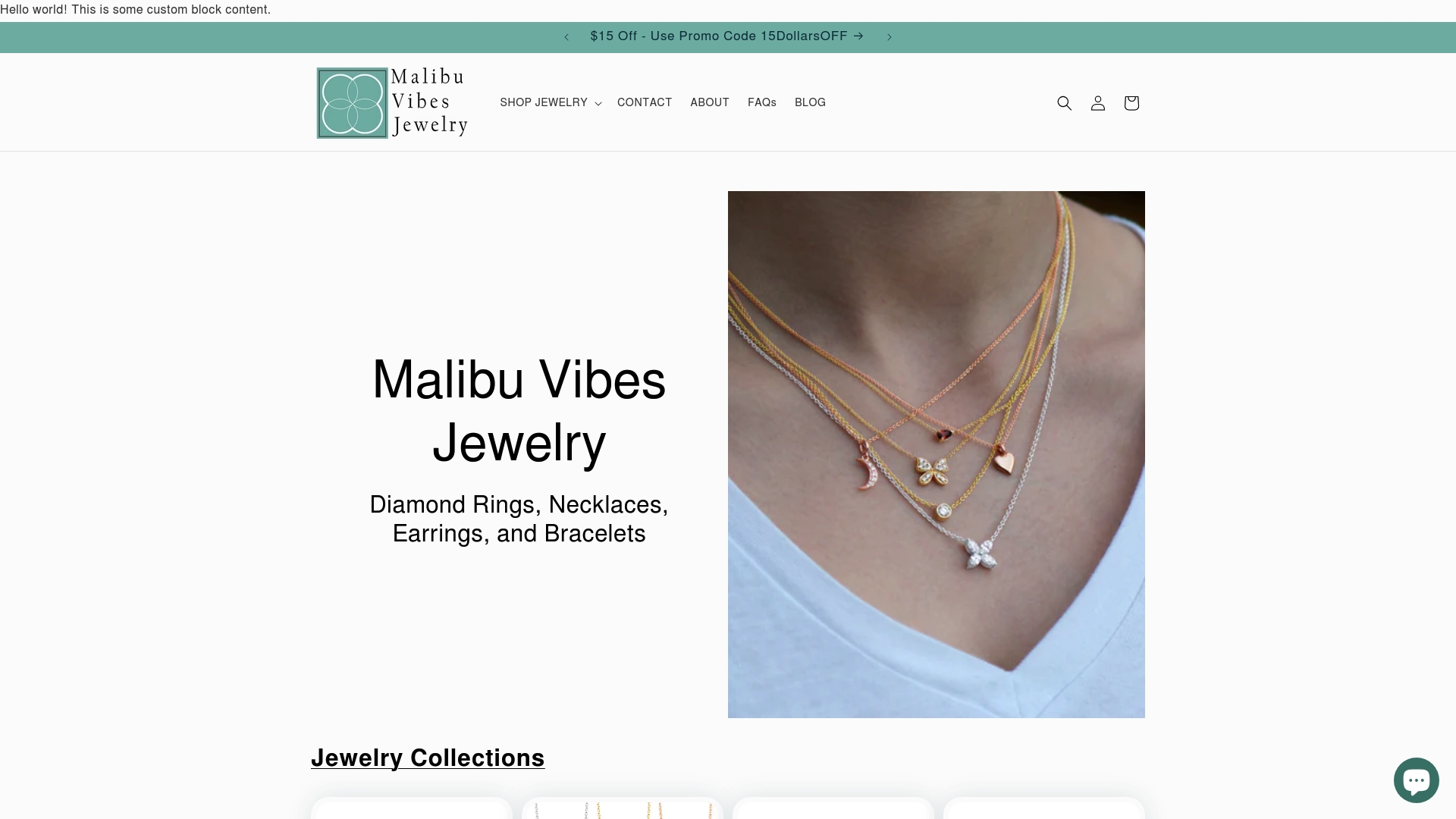Jewelry can add instant style to any outfit, but the story behind each piece matters now more than ever. People might not expect that traditional jewelry production can contribute up to 20 tons of toxic waste for every gold ring made. What is surprising is how sustainable jewelry is rewriting the script by turning these tarnished practices into symbols of real positive change.
Table of Contents
- Defining Sustainable Jewelry: What It Is
- The Importance Of Sustainable Jewelry In Today’s World
- How Sustainable Jewelry Is Made: Materials And Processes
- Key Concepts In Sustainable Jewelry: Fair Trade And Ethical Production
Quick Summary
| Takeaway | Explanation |
|---|---|
| Choose ethically sourced materials | Opt for jewelry made from recycled metals and lab-created gemstones to support sustainable practices. |
| Support fair labor practices | Ensure that your jewelry is produced under conditions that guarantee fair wages and safe environments for workers. |
| Promote environmental conservation | Selecting sustainable jewelry reduces habitat destruction, water pollution, and carbon emissions associated with traditional mining. |
| Verify supply chain transparency | Look for brands that provide traceability for their materials, ensuring ethical and responsible sourcing. |
| Make a statement with your purchases | Every jewelry purchase can reflect your commitment to social and environmental ethics, influencing industry standards. |
Defining Sustainable Jewelry: What It Is
Sustainable jewelry represents a conscious approach to creating and consuming accessories that prioritize environmental responsibility, ethical production, and long-term ecological preservation. Unlike traditional jewelry manufacturing, which often involves significant environmental damage and questionable labor practices, sustainable jewelry focuses on minimizing negative impacts while creating beautiful, meaningful pieces.
The Core Principles of Sustainable Jewelry
Sustainable jewelry is defined by several fundamental principles that distinguish it from conventional production methods. According to the Sustainable Living Association, these principles include:
- Ethical Material Sourcing: Using responsibly mined gemstones and metals that do not contribute to environmental destruction or human rights violations
- Minimal Environmental Impact: Reducing carbon footprint through eco-friendly production techniques
- Fair Labor Practices: Ensuring workers receive fair wages and safe working conditions throughout the supply chain
At its essence, sustainable jewelry transforms the traditional narrative of accessorizing from purely aesthetic consumption to a more holistic, responsible practice. This approach considers not just the final product, but the entire journey of creation, from raw material extraction to final crafting.
Below is a table summarizing the core principles that differentiate sustainable jewelry from traditional jewelry practices, making it easy to compare their defining features.
| Principle | Sustainable Jewelry | Traditional Jewelry |
|---|---|---|
| Material Sourcing | Ethically sourced/recycled metals and lab gemstones | Often newly mined, little oversight |
| Environmental Impact | Minimal—eco-friendly production, reduced carbon footprint | High—mining, pollution, habitat loss |
| Labor Practices | Fair wages, safe working conditions, no child labor | Often exploitative, safety issues |
| Supply Chain Transparency | High—traceable to origin | Often opaque, hard to trace origins |
| Social Responsibility | Supports communities, invests in local development | Rarely contributes back to communities |
Understanding Material Sustainability
Material selection plays a crucial role in defining sustainable jewelry. Responsible manufacturers prioritize recycled metals like reclaimed gold and silver, lab-created gemstones, and materials sourced through verified ethical channels. The American Gem Trade Association emphasizes the importance of traceability, ensuring that every component can be tracked to its origin with minimal environmental disruption.
Sustainable jewelry isn’t just about reducing harm - it’s about creating positive change. By choosing pieces crafted with environmental consciousness, consumers become active participants in promoting more responsible industrial practices. Learn more about crafting techniques in our guide to fine jewelry craftsmanship.
The Importance of Sustainable Jewelry in Today’s World
Sustainable jewelry has emerged as a critical response to the environmental and social challenges posed by traditional jewelry manufacturing. As global awareness about ecological preservation and ethical production grows, consumers are increasingly demanding accessories that reflect their values and commitment to responsible consumption.
Environmental Impact and Conservation
According to research from the Frontiers in Business, Economics and Management journal, the jewelry industry has historically been associated with significant environmental degradation. Traditional mining practices contribute to numerous ecological challenges:
- Habitat Destruction: Mining operations often devastate local ecosystems and disrupt wildlife habitats
- Water Pollution: Extraction processes can contaminate water sources with harmful chemicals
- Carbon Emissions: Mining and metal processing generate substantial greenhouse gas emissions
Sustainable jewelry offers a transformative approach by prioritizing recycled materials, reducing carbon footprints, and minimizing environmental harm. By choosing eco-friendly accessories, consumers directly support conservation efforts and contribute to global sustainability goals.
Social Responsibility and Ethical Production
Beyond environmental considerations, sustainable jewelry represents a commitment to human rights and fair labor practices. The industry has long been criticized for exploitative working conditions and unethical sourcing methods. Sustainable jewelry brands challenge these practices by ensuring:
- Transparent supply chains
- Fair wages for artisans and miners
- Safe working environments
- Elimination of child labor
By supporting sustainable investment in precious metals, consumers become active participants in promoting social justice and ethical economic practices. Each purchase becomes a statement of solidarity with workers and communities involved in jewelry production.
The following table highlights the main environmental and social issues associated with traditional jewelry compared to the solutions provided by sustainable jewelry, helping readers quickly understand the advantages of sustainability-focused practices.
| Issue | Traditional Jewelry | Sustainable Jewelry |
|---|---|---|
| Habitat Destruction | Common due to extensive mining | Minimized by using recycled/ethical sources |
| Water Pollution | Frequent from mining chemicals | Controlled or eliminated with lab gems |
| Carbon Emissions | High from extraction/processing | Reduced via eco-friendly methods |
| Fair Labor Practices | Often lacking, risk of exploitation | Prioritized: fair wages, safe workplaces |
| Supply Chain Transparency | Limited and opaque | Full transparency and traceability |
Ultimately, sustainable jewelry is more than a trend—it represents a fundamental reimagining of how we produce, consume, and value accessories. It demonstrates that beauty and responsibility can coexist, creating a more equitable and environmentally conscious future for the global jewelry industry.
How Sustainable Jewelry is Made: Materials and Processes
Sustainable jewelry production represents a sophisticated approach to creating beautiful accessories while minimizing environmental impact and maximizing ethical practices. The process involves carefully selected materials, innovative manufacturing techniques, and a commitment to reducing the ecological footprint of jewelry creation.
Responsible Material Sourcing
According to the Sustainable Living Association, sustainable jewelry relies on three primary material strategies:
- Recycled Metals: Reusing existing gold, silver, and platinum from previously manufactured jewelry or industrial sources
- Lab-Created Gemstones: Producing gemstones in controlled environments that eliminate mining-related environmental damage
- Ethically Sourced Natural Materials: Selecting raw materials from mines and sources that adhere to strict environmental and labor standards
These material choices dramatically reduce the environmental strain typically associated with traditional jewelry manufacturing.
 By prioritizing recycled and responsibly sourced materials, sustainable jewelry brands significantly decrease the demand for new mining operations.
By prioritizing recycled and responsibly sourced materials, sustainable jewelry brands significantly decrease the demand for new mining operations.
Advanced Manufacturing Techniques
Sustainable jewelry production goes beyond material selection, incorporating advanced manufacturing processes designed to minimize waste and environmental impact. Artisans and manufacturers employ techniques such as:
- Precision casting to reduce metal waste
- Water-efficient production methods
- Low-emission workshop practices
- Renewable energy powered manufacturing facilities
Technological innovations have made it possible to create intricate, high-quality pieces while maintaining strict environmental standards. Check out our detailed guide on fine jewelry making processes to understand the intricate craftsmanship behind sustainable jewelry creation.
Traceability and Transparency
A crucial aspect of sustainable jewelry production is complete transparency throughout the supply chain.
Manufacturers now use advanced tracking technologies to document the origin of every material, ensuring that consumers can verify the ethical and environmental credentials of their jewelry. This approach not only builds trust but also holds the entire industry to higher standards of accountability and responsible production.
Key Concepts in Sustainable Jewelry: Fair Trade and Ethical Production
Sustainable jewelry transcends mere aesthetic appeal, embedding profound social and economic principles that challenge traditional manufacturing paradigms. Fair trade and ethical production represent the cornerstone of responsible jewelry creation, ensuring that every piece tells a story of human dignity and environmental stewardship.
Understanding Fair Trade Principles
According to the National Jeweler, sustainable jewelry fundamentally reimagines the economic relationships within the production process. Fair trade principles in jewelry manufacturing encompass several critical components:
- Transparent Wage Structures: Guaranteeing fair compensation that exceeds minimum wage standards
- Safe Working Conditions: Providing secure, healthy environments for artisans and miners
- Community Development: Reinvesting profits into local infrastructure and educational programs
- Prohibition of Child Labor: Strictly enforcing age restrictions and protecting worker rights
These principles transform jewelry from a mere consumer product into a mechanism for social empowerment and economic justice. By prioritizing human welfare, fair trade jewelry challenges exploitative industrial practices that have historically marginalized workers in developing regions.
Ethical Production Beyond Economics
Ethical production extends far beyond financial considerations, encompassing comprehensive approaches to environmental and social responsibility. Sustainable jewelry brands implement rigorous standards that address:
- Comprehensive supply chain transparency
- Minimal environmental disruption
- Respect for indigenous communities and their traditional knowledge
- Protection of workers’ fundamental human rights
Explore our guide to minimalist jewelry design to understand how aesthetic simplicity can align with ethical production values.
Certification and Verification
To substantiate ethical claims, sustainable jewelry relies on robust certification mechanisms. Independent third-party organizations audit manufacturing processes, verifying compliance with international labor standards and environmental protocols. These certifications provide consumers with tangible proof that their purchasing decisions support genuine social and ecological responsibility, transforming jewelry from a personal accessory into a statement of global citizenship.

Choose Sustainable Beauty with Malibu Vibes Jewelry
You care about making mindful choices and you want your accessories to reflect your values. The article laid out the challenges of traditional jewelry, including environmental harm, unfair labor, and the importance of traceability and ethical sourcing. At Malibu Vibes Jewelry, every piece in our Celestial Jewelry collection is made with the environment and people in mind, using materials and craftsmanship that align with the principles of true sustainability.

Ready to make an impact through the jewelry you wear? Shop our eco-conscious designs today to support a more ethical and beautiful world. Explore our Solid Gold Necklaces or visit Malibu Vibes Jewelry to discover the difference responsible jewelry makes. Now is the perfect time to find pieces that are both stunning and sustainable.
Frequently Asked Questions
What is sustainable jewelry?
Sustainable jewelry refers to accessories that are created with a focus on environmental responsibility and ethical production. This includes the use of responsibly sourced materials, minimal environmental impact, and fair labor practices throughout the supply chain.
What materials are commonly used in sustainable jewelry?
Sustainable jewelry typically uses recycled metals, lab-created gemstones, and ethically sourced natural materials. These choices help minimize environmental harm associated with traditional mining and production practices.
How does sustainable jewelry benefit the environment?
Sustainable jewelry helps reduce ecological damage by prioritizing materials that require no new mining, decreasing carbon emissions through eco-friendly production methods, and promoting conservation efforts through responsible practices.
What principles define ethical production in jewelry?
Ethical production in jewelry is defined by principles such as fair labor practices, safe working conditions, transparency in the supply chain, and the prohibition of child labor. These principles ensure that workers are treated fairly and that environmental standards are upheld.
Recommended
- What is Minimalist Jewelry? Understanding Its Beauty and Significance – Malibu Vibes Jewelry
- 7 Key Differences Between Fashion Jewelry vs Fine Jewelry – Malibu Vibes Jewelry
- What is Custom Jewelry? Understanding Unique Creations – Malibu Vibes Jewelry
- What is Statement Jewelry: Understanding Its Impact and Style – Malibu Vibes Jewelry
- Why Chunky Vintage Earrings are Making a Comeback



